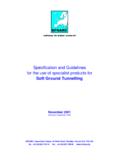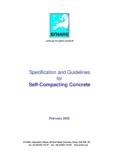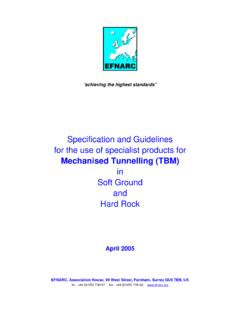Transcription of ERMCO - efnarc.org
1 ERMCO The European Guidelines for Self-Compacting Concrete Specification, Production and Use May 2005 The European Guidelines for Self Compacting Concrete FOREWORD These Guidelines and specifications were prepared by a project group comprising five European Federations dedicated to the promotion of advanced materials, and systems for the supply and use of concrete. The Self-Compacting Concrete European Project Group was founded in January 2004 with representatives from: BIBM The European Precast Concrete Organisation. CEMBUREAU The European Cement Association. ERMCO The European Ready-mix Concrete Organisation. EFCA The European Federation of Concrete Admixture Associations. EFNARC The European Federation of Specialist Construction Chemicals and Concrete Systems. All comments on The European Guidelines for Self Compacting Concrete should be submitted to the EPG Secretary at: or ACKNOWLEDGEMENT The European Project Group acknowledges the contribution made in drafting this document by a wide range of expertise from within the concrete and construction industry.
2 The five EPG working groups drew on the SCC experience of more than 50 people from 12 European countries and on collaboration with the The UK Concrete Society and the EC TESTING-SCC project 2001-2004. Diagrams and photographs provided by: Betonson BV, NL Price and Myers Consulting Engineers Degussa Lafarge Doka Schalungstechnik GmbH Sika Hanson The TESTING-SCC project Holcim W. Bennenk Although care has been taken to ensure, to the best of our knowledge that all data and information contained herein is accurate to the extent that it relates to either matters of fact or accepted practice or matters of opinion at the time of publication, the SCC joint project group assumes no responsibility for any errors in or misrepresentation of such data and/or information or any loss or damage arising from or related to its use.
3 All rights reserved. No part of this publication may be reproduced, stored in a retrieval system or transmitted, in any form or by any means, electronic, mechanical, recording or otherwise, without prior permission of the SCC European Project 028 ii The European Guidelines for Self Compacting Concrete CONTENTS 1 Introduction 1 2 Scope 1 3 Referenced standards 3 4 Terms and definitions 3 5 Engineering properties 5 general Compressive strength Tensile strength Static modulus
4 Of elasticity Creep Shrinkage Coefficient of thermal expansion Bond to reinforcement, prestressing and wires Shear force capacity across pour planes Fire resistance Durability References 6 Specifying SCC for ready-mixed & site mixed concrete 10 general Specification Requirements in the fresh state Consistence classification Specification examples 7 Constituent materials 15 general Cement Additions Aggregates Admixtures Pigments Fibres Mixing water 8 Mix composition 19 general Mix design principles Test
5 Methods Basic mix design Mix design approach Robustness in the fresh state SCC 028 iii The European Guidelines for Self Compacting Concrete 9 Production for ready-mixed and site mixed SCC 24 general Storage of constituent materials Mixing equipment and trial mixes Plant mixing procedures Production control Transportation and delivery Site acceptance 10 Site requirements and preparation 28 general Site control Mix adjustment Supervision and skills Formwork pressure Formwork design Formwork preparation Formwork for pumping bottom up 11 Placing and finishing on site 32 general Discharging Placing procedure and rate Placing by pump Placing by concrete chute or skip Vibration Finishing slabs Curing 12 Precast concrete products 37 general Specifying SCC for use in precast concrete products Mix design of SCC for precast concrete products Moulds Factory production Placing Finishing.
6 Curing and de-moulding 13 Appearance and surface finish 40 general Blowholes Honeycombing Colour consistency and surface aberrations Minimising surface cracking SCC 028 iv The European Guidelines for Self Compacting Concrete ANNEX A Specification of SCC 43 Scope Normative references Definitions, symbols and abbreviations Classification Requirements for concrete and methods of verification Delivery of fresh concrete Conformity control and conformity criteria Production control B Test methods for SCC 47 B1: Slump-flow and T500 time B2: V-funnel test B3: L-box test B4.
7 Sieve segregation resistance test C Improving the finish of SCC 60 SCC 028 v The European Guidelines for Self Compacting Concrete 1 Introduction Self-compacting concrete (SCC) is an innovative concrete that does not require vibration for placing and compaction. It is able to flow under its own weight, completely filling formwork and achieving full compaction, even in the presence of congested reinforcement. The hardened concrete is dense, homogeneous and has the same engineering properties and durability as traditional vibrated concrete. Concrete that requires little vibration or compaction has been used in Europe since the early 1970s but self-compacting concrete was not developed until the late 1980 s in Japan. In Europe it was probably first used in civil works for transportation networks in Sweden in the mid1990 s.
8 The EC funded a multi-national, industry lead project SCC 1997-2000 and since then SCC has found increasing use in all European countries. Self-compacting concrete offers a rapid rate of concrete placement, with faster construction times and ease of flow around congested reinforcement. The fluidity and segregation resistance of SCC ensures a high level of homogeneity, minimal concrete voids and uniform concrete strength, providing the potential for a superior level of finish and durability to the structure. SCC is often produced with low water-cement ratio providing the potential for high early strength, earlier demoulding and faster use of elements and structures. The elimination of vibrating equipment improves the environment on and near construction and precast sites where concrete is being placed, reducing the exposure of workers to noise and vibration. The improved construction practice and performance, combined with the health and safety benefits, make SCC a very attractive solution for both precast concrete and civil engineering construction.
9 In 2002 EFNARC published their Specification & Guidelines for Self-Compacting concrete which, at that time, provided state of the art information for producers and users. Since then, much additional technical information on SCC has been published but European design, product and construction standards do not yet specifically refer to SCC and for site applications this has limited its wider acceptance, especially by specifiers and purchasers. In 1994 five European organisations BIBM, CEMBUREAU, ERMCO , EFCA and EFNARC, all dedicated to the promotion of advanced materials and systems for the supply and use of concrete, created a European Project Group to review current best practice and produce a new document covering all aspects of SCC. This document The European Guidelines for Self Compacting Concrete serves to particularly address those issues related to the absence of European specifications, standards and agreed test methods.
10 2 Scope The European Guidelines for Self Compacting Concrete represent a state of the art document addressed to those specifiers, designers, purchasers, producers and users who wish to enhance their expertise and use of SCC. The Guidelines have been prepared using the wide range of the experience and knowledge available to the European Project Group. The proposed specifications and related test methods for ready-mixed and site mixed concrete, are presented in a pre-normative format, intend to facilitate standardisation at European level. This approach should encourage increased acceptance and utilisation of SCC. The European Guidelines for Self Compacting Concrete define SCC and many of the technical terms used to describe its properties and use. They also provide information on standards related to testing and to associated constituent materials used in the production of SCC.











